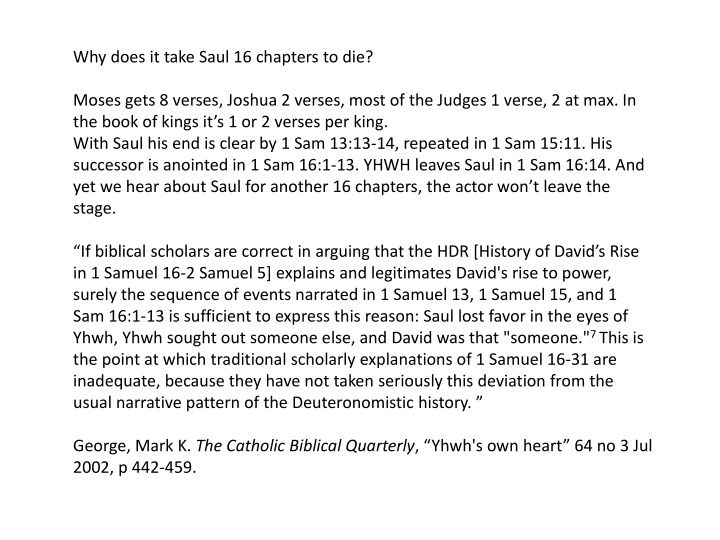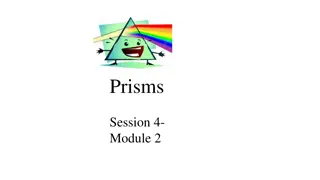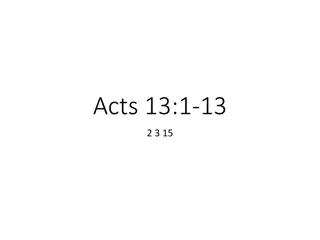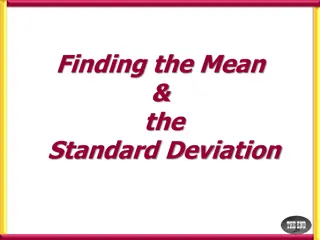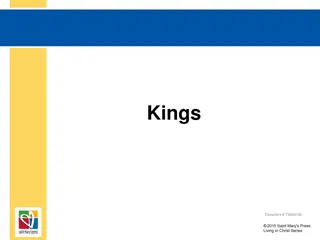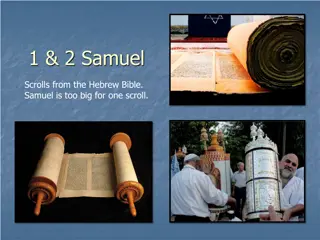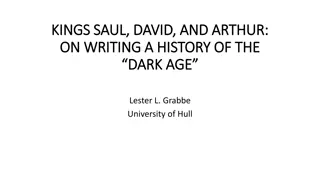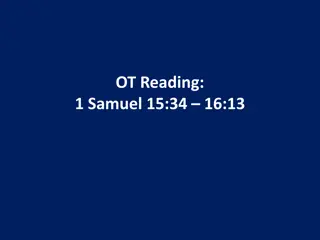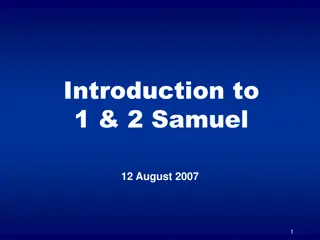Saul's Prolonged Narrative in 1 Samuel: A Deviation Explained
Exploring the extended narrative of Saul in the book of 1 Samuel compared to other biblical figures, this analysis delves into the theological and narrative reasons behind Saul's prolonged story. It examines the implications of Yhwh's abandonment of Saul and the emergence of David as the chosen one, shedding light on the construction of religious identity in ancient Israel during the Deuteronomistic history's formation.
Download Presentation

Please find below an Image/Link to download the presentation.
The content on the website is provided AS IS for your information and personal use only. It may not be sold, licensed, or shared on other websites without obtaining consent from the author.If you encounter any issues during the download, it is possible that the publisher has removed the file from their server.
You are allowed to download the files provided on this website for personal or commercial use, subject to the condition that they are used lawfully. All files are the property of their respective owners.
The content on the website is provided AS IS for your information and personal use only. It may not be sold, licensed, or shared on other websites without obtaining consent from the author.
E N D
Presentation Transcript
Why does it take Saul 16 chapters to die? Moses gets 8 verses, Joshua 2 verses, most of the Judges 1 verse, 2 at max. In the book of kings it s 1 or 2 verses per king. With Saul his end is clear by 1 Sam 13:13-14, repeated in 1 Sam 15:11. His successor is anointed in 1 Sam 16:1-13. YHWH leaves Saul in 1 Sam 16:14. And yet we hear about Saul for another 16 chapters, the actor won t leave the stage. If biblical scholars are correct in arguing that the HDR [History of David s Rise in 1 Samuel 16-2 Samuel 5] explains and legitimates David's rise to power, surely the sequence of events narrated in 1 Samuel 13, 1 Samuel 15, and 1 Sam 16:1-13 is sufficient to express this reason: Saul lost favor in the eyes of Yhwh, Yhwh sought out someone else, and David was that "someone."7 This is the point at which traditional scholarly explanations of 1 Samuel 16-31 are inadequate, because they have not taken seriously this deviation from the usual narrative pattern of the Deuteronomistic history. George, Mark K. The Catholic Biblical Quarterly, Yhwh's own heart 64 no 3 Jul 2002, p 442-459.
George, Mark K. The Catholic Biblical Quarterly, Yhwh's own heart 64 no 3 Jul 2002, p 442-459. Both David and Saul have 3 introductions Each character is described in terms of his name, genealogy, kinship, city, physical attributes, military activities, and theological identity. Both have the Spirit come on them after their anointing
Page 451 This sudden abandonment of Saul by Yhwh raises the question (among others) of who is this "man after [Yhwh's] own heart?" What does it mean to have a heart after Yhwh's own heart? It is the answer to these questions that the rest of 1 Samuel addresses. Why? Because the narrative is making an argument as to how religious identity in Israel is to be constructed and understood in the sixth century B.C.E., the period during which the Deuteronomistic history was shaped in its final form.26 To return to Gunn's argument that 1 Samuel 16-31 is "'serious' entertainment" that encourages the narrative's readers or listeners to "self- or social-reassessment," I would argue that part of the "reassessment" being encouraged in this narrative involves the way in which the narrative's readers or listeners understand and construct their religious identity. Constructing one's religious identity on the pattern of Saul is, ultimately and tragically, inadequate and insufficient. David, on the other hand, is the model for the proper understanding and construction of one's religious identity in Israel, at least according to these narratives.
Cultic Observance Saul has priestly attributes ascribed to his role as king The and what went with it (1 Sam 9:23-24) was the priestly portion (see Exod 29:27; Lev 7:32-34; 10:14-15; Num 6:20; 18:18.) Lot of other examples Page 453 In contrast to Saul, David is not narratively portrayed as one whose religious identity is constructed primarily around cultic observance. This is not to claim that David does not perform proper cultic observances. On the contrary, David does perform them, but he does so by inquiring of Yhwh and, more distinctively, declaring his trust (or faith) and confidence in Yhwh.34 It is through these actions that David reveals what it means to have a heart after Yhwh's own heart, and it is through David's character that the narrative presents its understanding of how religious identity should properly be constructed by "Israel" and "Judah."
P 454 David's repeated inquiries indicate why David is different from Saul, and thus why David has a heart after Yhwh's own heart. David is different from Saul (and David's heart is different from Saul's heart) because David continually seeks Yhwh's counsel and guidance before he acts. David's need for divine counsel and guidance results in a relationship with Yhwh different for him from that for Saul. David and Yhwh have a dialogue, something Saul and Yhwh do not have.
P 455 Declarations Inquiring of Yhwh before acting, however, is only part of what it means to have a heart after Yhwh's own heart. Another part involves declaring one's trust in Yhwh to act on one's behalf. The importance of such declarations is demonstrated by both David and, prior to him, Jonathan. Jonathan is the first character who might be the one Yhwh has sought out and who might have the appropriate type of heart (1 Samuel 14). Although Jonathan ultimately is not the person Yhwh has sought out, he does indicate what it means to have a heart after Yhwh's own heart, because he declares his trust in Yhwh.
P 456 In the very first words David speaks in the narrative, he refers to the Israelite army as "the armies of the living God" (1 Sam 17:26). This statement is a reconceptualization in this chapter of the theological nature of the Israelite army as the army of God and reflects the orientation and nature of David's heart.
P 457 Despite the economy of writing demonstrated in the Deuteronomistic history, the stories of Saul and David overlap for seventeen chapters because it is through the contrast of the two men that the narrative reveals what it means to have a heart after Yhwh's own heart. Saul and David are described as similar to each other in almost every way in the narrative, even to the point of including information that Yhwh has indicated is unimportant. These similarities set in high relief the one difference that does exist between the two characters, namely the type of heart each man has, which is the criterion Yhwh gave when he declared he had forsaken Saul (1 Samuel 13). The narrative does not, however, explicitly name what it is about David and his heart that leads Yhwh to have David anointed. Instead, the stories of Saul and David are overlapped so that the answers to these questions can be discovered by the reader. David is the man who has a heart after Yhwh's own heart because of his continual practice of inquiring of Yhwh and then declaring his trust in Yhwh, actions that stand in contrast to Saul's particular concern for cultic observance and failure to inquire continually of Yhwh. This is why it takes Saul so long to die in the narrative.
